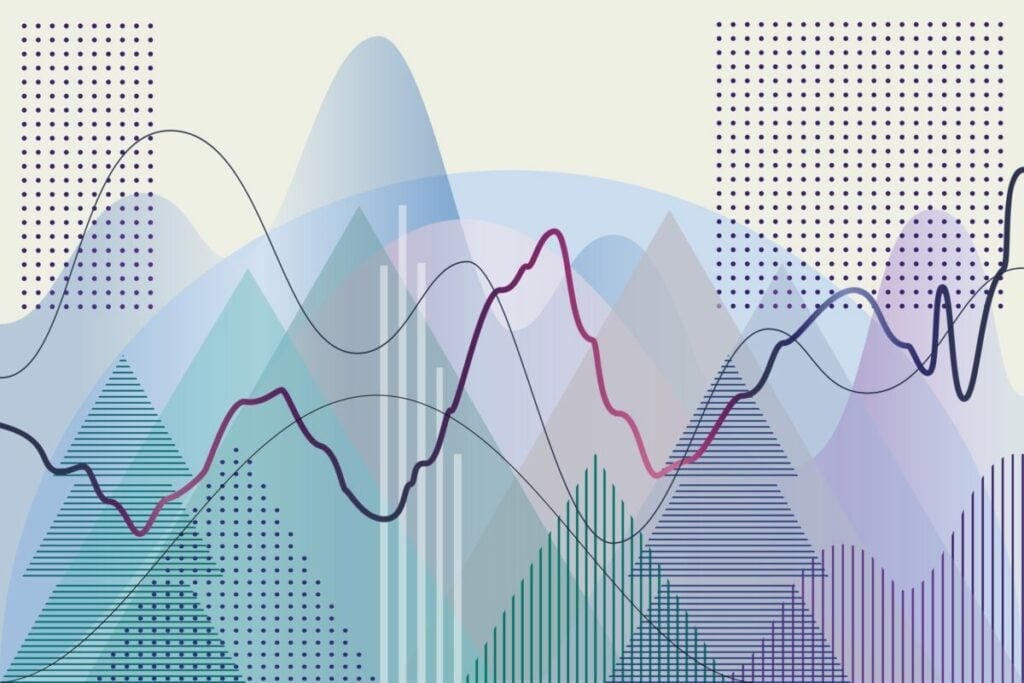In the financial markets, there is a saying that no one rings the bell at the top of bull markets. Additionally, traders are generally advised not to try to catch the falling knife. It is true that major market setbacks are difficult to take advantage of. But thanks to reversal indicators, such as parabolic patterns, we can more accurately predict these trend changes. In this article, we guide you through the parabolic curves trading strategy.
What is a parabolic candlestick pattern?
can refer to a situation where the price action on a chart shows a rapid and significant increase or decrease, resembling a parabola shape. This can be indicative of a strong bullish or bearish movement.
In trading, when we talk about something being “parabolic,” we generally mean that the price of an asset rises abruptly in a way that resembles the shape of a parabola. This is often due to a combination of speculative trading, strong bullish sentiment, and sometimes hype or market news driving the price.
However, it is important to note that while a parabolic move can be stimulating and profitable for traders who get in early, it is also considered unsustainable in the long term. Prices that rise on a parabolic curve often fall just as quickly, leading to what is known as a “parabolic burst.” This is where the price peaks and then drops dramatically.
How to recognize parabolic patterns on trading charts?
Parabolic curve patterns, which feature an upward curved trend line, are prevalent across all currency pairs and time frames, exemplified by a step formation. To trade this pattern, identify a strong uptrend and a series of measured pullbacks, then draw a curved trend line below the pullback lows. A short entry is usually established when the price retraces below this trend line.
These patterns are easy to detect and are characterized by an upward price trend with consolidation and retracement phases. The pattern indicates strong bullish control but is paradoxically a bearish signal as buying momentum often runs out over time, leading to a possible reversal. Prices typically retrace to pretrend levels, making the bullish phase a precursor to bearish market behavior.
As a stand-alone indicator, the Parabolic Curve Pattern can work independently or in conjunction with other technical elements, such as Fibonacci Retracements, to set profit targets for short positions, thus proving its validity within trading management.
How to trade parabola patterns?

Suppose you are trading the EUR/USD currency pair and have identified a parabolic chart pattern on the daily time frame.
Identification of the parabolic pattern
- Note that EUR/USD has been in a strong uptrend, creating higher highs and higher lows.
- The price begins to accelerate and the movements become more pronounced, forming a curve reminiscent of a parabola on the chart.
Analysis and Planning
- You recognize that while the parabolic pattern signals a strong uptrend, it often precedes a strong reversal.
- You decide to wait for confirmation of a possible reversal before starting a trade.
Confirmation and Entry
- After a few days, you notice the price falls below the parabolic curve, suggesting that the buying pressure is exhausting.
- It also sees higher volume on low days and a bearish candlestick pattern, confirming its bearish bias.
- You decide to enter a short position, anticipating a significant reversal or pullback.
- Place a short sell order slightly below the last low, just after the price breaks the parabolic curve.
Set Stop Loss and Take Profit
- Set a stop loss just above the highest point of the parabolic curve to protect your trade from a false breakout.
- To make profits, you can use Fibonacci retracement levels to identify possible support levels where the price could recover.
Commercial management
- As the price begins to move in your favor, you monitor the price action and adjust your trailing stops to lock in profits.
- You remain alert for signs of a reversal or slowdown in momentum, ready to exit if market conditions change.
Starting point
Once the price reaches your take profit level or you notice signs of a bullish reversal (such as a bullish candlestick pattern or a breakout above resistance levels), you exit the trade to capture your profits.
Parabolic Chart Pattern – Pros and Cons


Below is a detailed analysis of the pros and cons of this trading indicator.
Advantages
Occurs on all time frames in forex pairs, CFDs and stocks:
- Versatility: The pattern's ability to manifest itself in various markets (Forex, contracts for difference and equity markets) and in different time frames makes it a versatile tool for traders. It is not limited to a specific asset class or time horizon, allowing for broad applicability.
- Inclusive for different trading styles: Whether you are a day trader, swing trader or long-term investor, the parabolic pattern can be part of your analysis toolkit, thanks to its presence in different time frames.
- Relatively easy to locate market entry, stop losses and profit targets:
- Clear Entry Points – The pattern often provides distinct and recognizable setups, allowing traders to identify entry points with relative ease.
- Risk Management: It also helps in placing stop loss orders effectively. Traders can place their stops below the parabolic curve or the most recent support level.
- Profit Targets: The pattern can project potential price targets, helping traders lock in profits before the trend reverses.
- It can produce significant profits on longer time frame charts:
- Big Moves – The parabolic pattern often precedes substantial price moves, especially on higher time frames, providing the potential for considerable profits.
- Trend Confirmation – Over longer time frames, it can serve as confirmation of a strong, continuing trend, allowing traders to capitalize on momentum.
Cons
- Loses effectiveness in rotating markets.
- Sideways Markets: The pattern is mainly based on trends. In markets that are range-bound or experiencing sideways movements, their predictive power decreases significantly.
- Misleading Signals: During these periods, what appears to be the beginning of a parabolic move could simply be a price fluctuation within a broader, directionless market phase.
- Strong bullish trends can produce false signals.
- Risk of reversals: Even if a parabolic pattern begins to form, strong uptrends can reverse sharply, especially if the uptrend was speculative and not supported by fundamental factors.
- Determining bear market tracking toward earnings targets can be challenging.
- Bearish Predictability: While the pattern may clearly indicate the beginning of a bearish phase, predicting the extent and duration of this phase can be complex. The market may not move as expected, making it difficult to determine accurate profit targets.
In conclusion
The parabolic pattern offers information on crucial price levels and guides traders to set strategic trailing stops. As you navigate through support and resistance levels, understanding parabolic patterns becomes essential to effectively timing when to enter the market.
Whether you are holding long positions, contemplating a short position, or adjusting position size, these patterns serve as a compass in tumultuous financial markets.
Along with fundamental analysis and tools like Fibonacci retracement levels, this article aims to improve your trading acumen over any period of time, ensuring your strategies stand the test of time in the ever-evolving stock market. Dive into our table of contents for a complete guide that captures the end result of trading with parabolic patterns.
!function(f,b,e,v,n,t,s){if(f.fbq)return;n=f.fbq=function(){n.callMethod?n.callMethod.apply(n,arguments):n.queue.push(arguments)};if(!f._fbq)f._fbq=n;n.push=n;n.loaded=!0;n.version=’2.0′;n.queue=();t=b.createElement(e);t.async=!0;t.src=v;s=b.getElementsByTagName(e)(0);s.parentNode.insertBefore(t,s)}(window,document,’script’,’https://connect.facebook.net/en_US/fbevents.js’);fbq(‘init’,’504526293689977′);fbq(‘track’,’PageView’)






